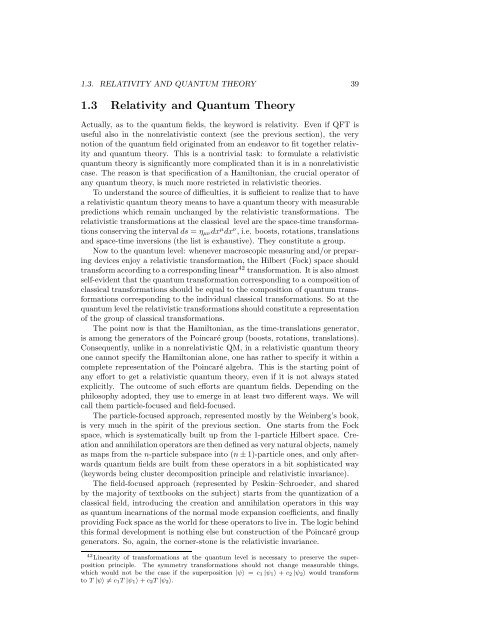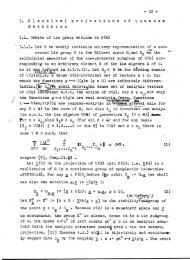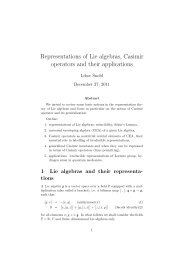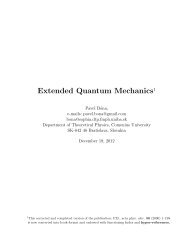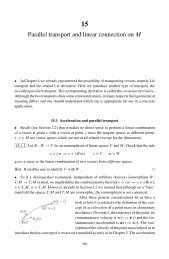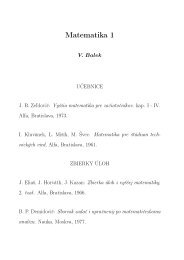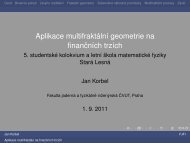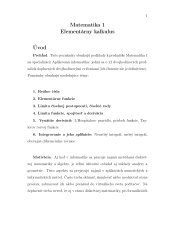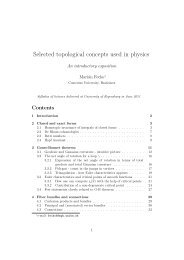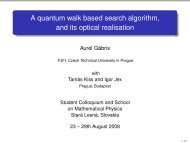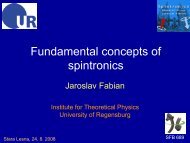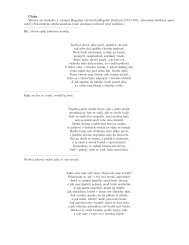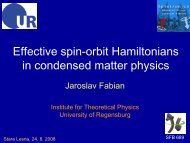Quantum Field Theory I
Quantum Field Theory I
Quantum Field Theory I
You also want an ePaper? Increase the reach of your titles
YUMPU automatically turns print PDFs into web optimized ePapers that Google loves.
1.3. RELATIVITY AND QUANTUM THEORY 39<br />
1.3 Relativity and <strong>Quantum</strong> <strong>Theory</strong><br />
Actually, as to the quantum fields, the keyword is relativity. Even if QFT is<br />
useful also in the nonrelativistic context (see the previous section), the very<br />
notion of the quantum field originated from an endeavor to fit together relativity<br />
and quantum theory. This is a nontrivial task: to formulate a relativistic<br />
quantum theory is significantly more complicated than it is in a nonrelativistic<br />
case. The reason is that specification of a Hamiltonian, the crucial operator of<br />
any quantum theory, is much more restricted in relativistic theories.<br />
To understand the source of difficulties, it is sufficient to realize that to have<br />
a relativistic quantum theory means to have a quantum theory with measurable<br />
predictions which remain unchanged by the relativistic transformations. The<br />
relativistic transformations at the classical level are the space-time transformationsconservingthe<br />
intervalds = η µν dx µ dx ν , i.e. boosts, rotations,translations<br />
and space-time inversions (the list is exhaustive). They constitute a group.<br />
Now to the quantum level: whenever macroscopic measuring and/or preparing<br />
devices enjoy a relativistic transformation, the Hilbert (Fock) space should<br />
transformaccordingtoacorrespondinglinear 42 transformation. Itisalsoalmost<br />
self-evident that the quantum transformation corresponding to a composition of<br />
classical transformations should be equal to the composition of quantum transformations<br />
corresponding to the individual classical transformations. So at the<br />
quantumleveltherelativistictransformationsshouldconstitutearepresentation<br />
of the group of classical transformations.<br />
The point now is that the Hamiltonian, as the time-translations generator,<br />
is among the generators of the Poincaré group (boosts, rotations, translations).<br />
Consequently, unlike in a nonrelativistic QM, in a relativistic quantum theory<br />
one cannot specify the Hamiltonian alone, one has rather to specify it within a<br />
complete representation of the Poincaré algebra. This is the starting point of<br />
any effort to get a relativistic quantum theory, even if it is not always stated<br />
explicitly. The outcome of such efforts are quantum fields. Depending on the<br />
philosophy adopted, they use to emerge in at least two different ways. We will<br />
call them particle-focused and field-focused.<br />
The particle-focused approach, represented mostly by the Weinberg’s book,<br />
is very much in the spirit of the previous section. One starts from the Fock<br />
space, which is systematically built up from the 1-particle Hilbert space. Creationandannihilationoperatorsarethendefinedasverynaturalobjects,namely<br />
as maps from the n-particle subspace into (n±1)-particle ones, and only afterwards<br />
quantum fields are built from these operators in a bit sophisticated way<br />
(keywords being cluster decomposition principle and relativistic invariance).<br />
The field-focused approach (represented by Peskin–Schroeder, and shared<br />
by the majority of textbooks on the subject) starts from the quantization of a<br />
classical field, introducing the creation and annihilation operators in this way<br />
as quantum incarnations of the normal mode expansion coefficients, and finally<br />
providingFockspaceasthe worldforthese operatorstolivein. The logicbehind<br />
this formal development is nothing else but construction of the Poincaré group<br />
generators. So, again, the corner-stone is the relativistic invariance.<br />
42 Linearity of transformations at the quantum level is necessary to preserve the superposition<br />
principle. The symmetry transformations should not change measurable things,<br />
which would not be the case if the superposition |ψ〉 = c 1 |ψ 1 〉 + c 2 |ψ 2 〉 would transform<br />
to T |ψ〉 ≠ c 1 T |ψ 1 〉+c 2 T |ψ 2 〉.


